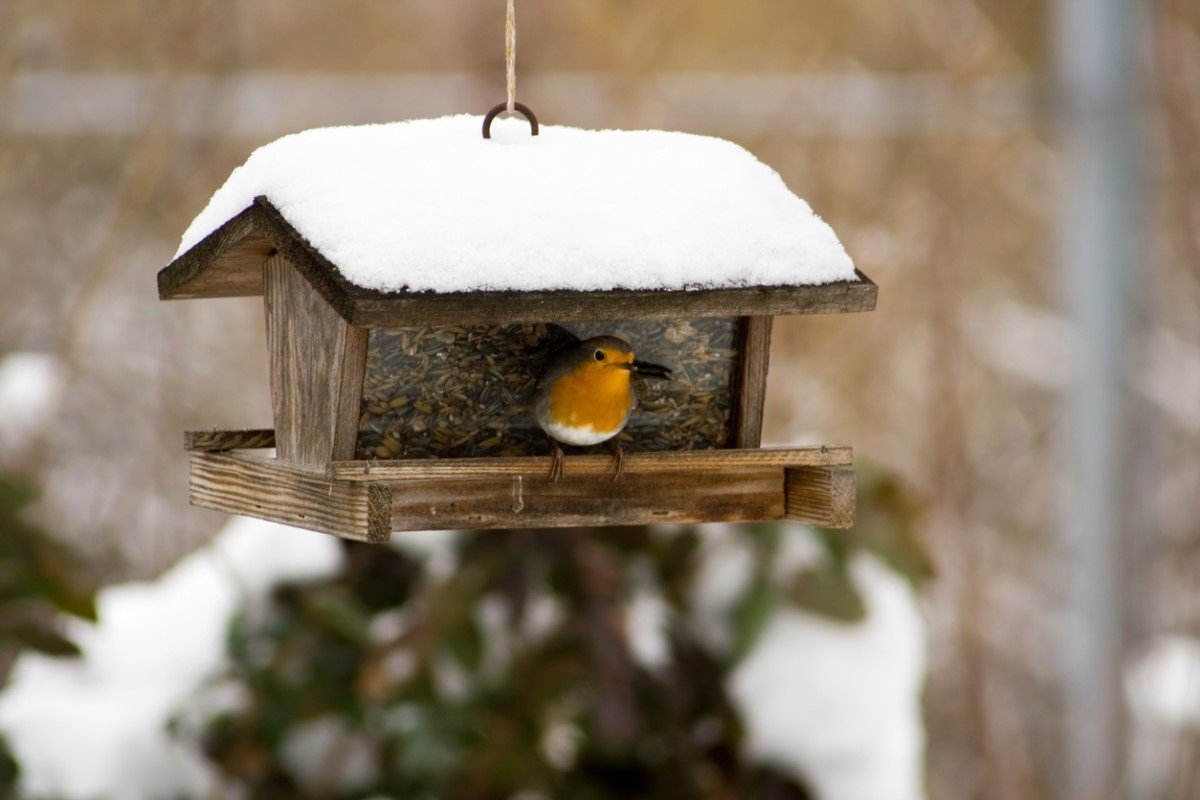

We may earn revenue from the products available on this page and participate in affiliate programs. Learn More ›
Backyard bird watching in the winter is a popular pastime, providing a lovely dose of nature during what can be the harshest time of the year. While there are different theories on whether it is in wild birds’ best long-term interest to feed them during winter, the majority of research indicates that putting food out for backyard birds improves their chance of survival when cold conditions can make their natural diet scarce. It also puts birds in a better position for success once the weather warms and breeding begins. And, according to Ornithologist Dr. Roger Lederer, “depending on where one lives, the kinds of birds visiting the feeder will be different or very different. Feeding birds in Vermont is very different than feeding birds in Arizona.” If you’ll be setting out food for birds on your property this season, keep these tips in mind.
RELATED: Pro Tips: 5 Ways to Bring Songbirds to Your Backyard
1. Offer high-quality birdseed.
When feeding birds in winter, give them the best, freshest food you can afford. “What birds need in the winter is protein and fat, especially fat to support them over a very cold night,” says Lederer. “Smaller birds have to increase their weight by 10 percent before nightfall to make it through a cold night and fat is the most important food source.” Choose a bird seed mix that appeals to a wide variety of birds, such as Wagner’s Greatest Variety Blend. Cheaper brands contain fillers, and seed on the clearance rack may be past its prime—neither case being healthy for birds. You’ll know if the seed is inferior or spoiled if you find an abundance left uneaten on the ground under your feeders. If so, empty the feeder, clean it thoroughly, and fill it with new, high-quality seed.
2. Provide for a variety of species that may visit to feed this winter.
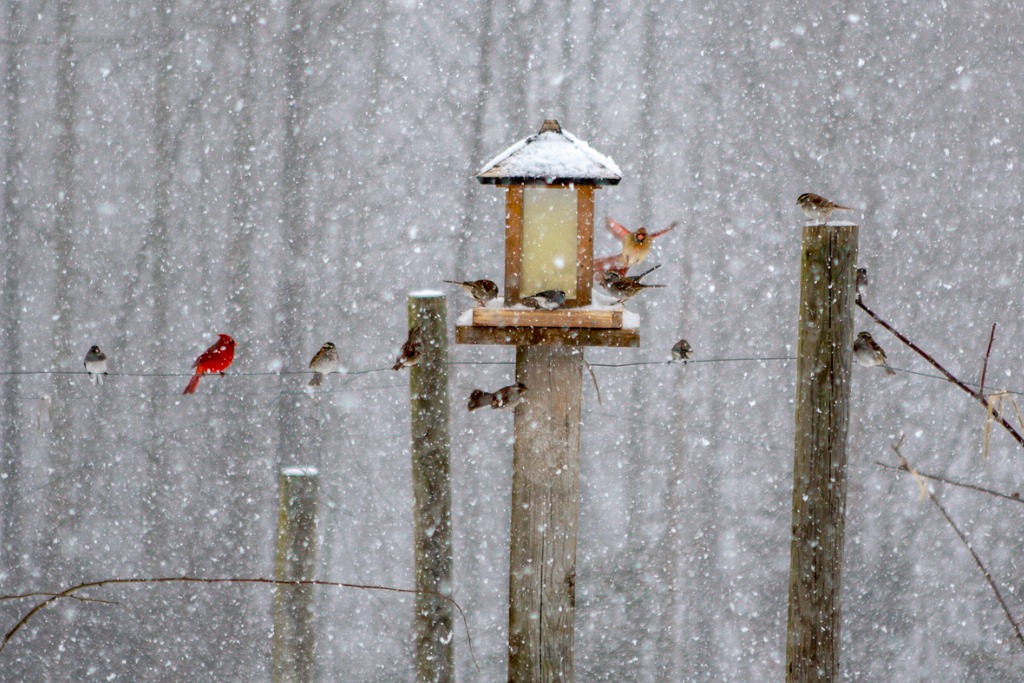
Different birds have different requirements and preferences when it comes to food and feeding habits. To attract a variety of bird species in wintertime, use a variety of foods. “Black oil sunflower seeds are really good for a variety of birds,” says Lederer. You’ll also want to provide several types of feeders—a thistle feeder brings finches running—hung at varying levels. Providing several areas to feed will prevent overcrowding, reducing negative interactions between competing species and lessening the likelihood of them spreading disease to one another.
RELATED: The Best Bird Feeders, Tested and Reviewed
3. Place bird feeders in a safe area.
While placing bird feeders, make sure you’re not unintentionally creating a bird buffet for such hawks, raccoons, snakes, and foxes. Put feeders several feet from the natural cover of trees and bushes so birds can hide in the event of an ambush, yet far enough away so that predators can’t lie in wait for them there. “Either put the bird feeder right next to the house or far away; this keeps the birds from flying into the house when taking off, Dr. Lederer tells us. “Put it near vegetation so they can hide but not in the vegetation so that predators can hide under the feeder. Out of the wind is best.” You might also provide some mesh or temporary fencing around the feeder area to help to keep predators at bay. And if raccoons are a problem, an extended hook, such as the Gray Bunny Heavy-Duty Deck Hook, keeps bird feeders out of their reach.
RELATED: The Best Place to Hang Bird Feeders for Safety and Optimal Viewing
4. Clean bird feeders regularly.
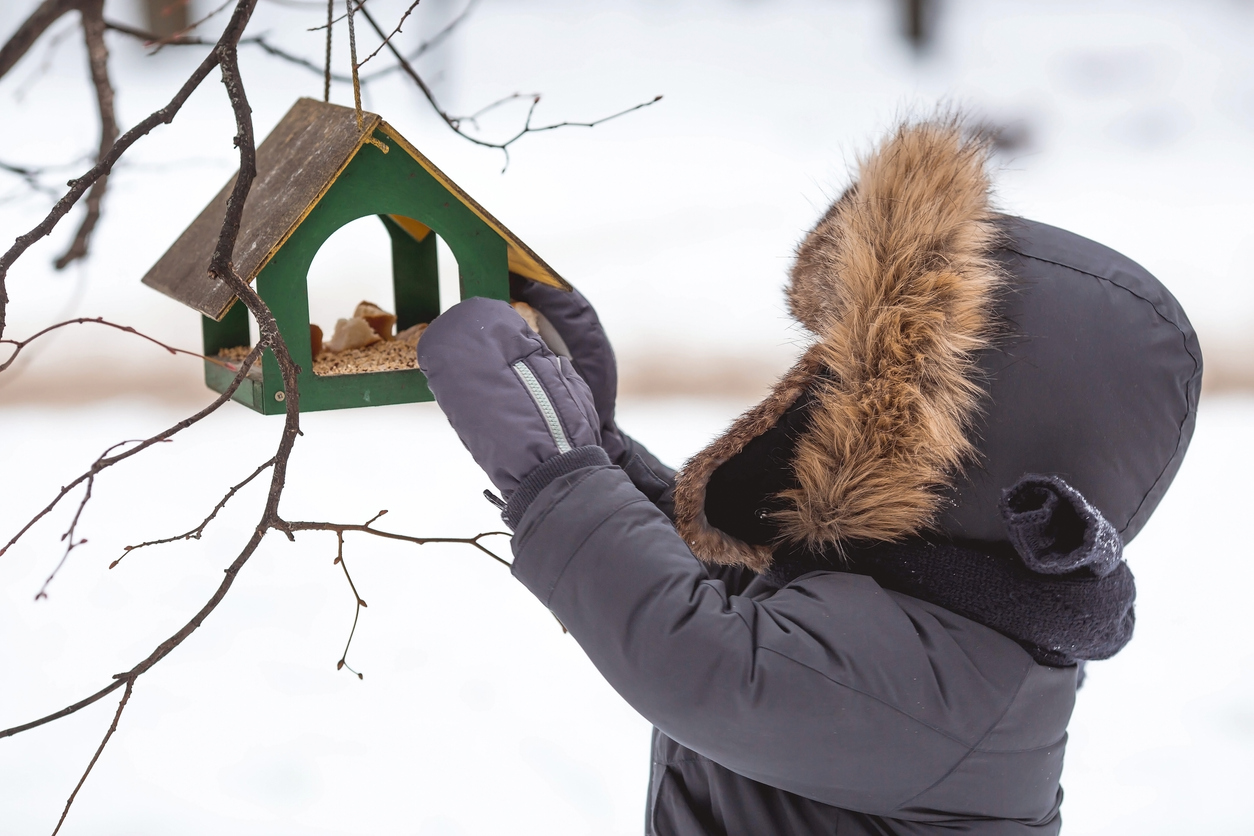
Keep bird feeders scrupulously clean by scrubbing thoroughly with dish soap, rinsing with a solution of 1-part non-chlorine bleach to 9-parts hot water, and finishing with a thorough rinse with clean water at least once per month. Dirty bird feeders become breeding grounds for bacteria, mold, and viruses that can sicken your feathered visitors. Birds can also become ill from food that’s contaminated with mold or bacteria, so replace uneaten food at least once per week, and more frequently if the seed becomes wet. Sweep up spilled food and hulls from beneath the bird feeders daily to discourage foraging rodents, and remove snow after storms to keep seed dry and ensure birds have access to it.
5. Store bird seed correctly to keep it safe and fresh.
Birdseed must be stored properly to keep it fresh and safe from bugs, rodents, and squirrels who may also be looking for a meal. Store all seed in a cool dry place, like a garage, shed, or covered porch. Use a sealed container, like a large plastic tub or metal garbage can with a lid, for large stockpiles of birdseed. In winter, use a spouted container that makes it easy to fill feeders without removing your gloves, such as the More Birds 3-N-1 Bird Seed Tote and Container.
RELATED: The Best Squirrel-Proof Bird Feeders, Tested and Reviewed
6. Fill your feeders every day.
“I think you want to keep seed out 24 hours a day, but the most crucial times are the few hours before sunset,” Dr. Lederer states. As it requires a great deal of energy to withstand winter’s long, dark nights, birds typically do the majority of their foraging for food or visiting of bird feeders late in the afternoon to prepare for the night ahead. They’re also active first thing in the morning to restore their energy reserves after spending the night hunkered down with feathers fluffed to create insulation. Help them out by filling your feeders each day in advance of the afternoon rush. That way, your feathered visitors can dine before darkness falls, and you won’t have to get up before dawn to refill the feeders before the early birds arrive for breakfast.
7. Provide a source of fresh water.
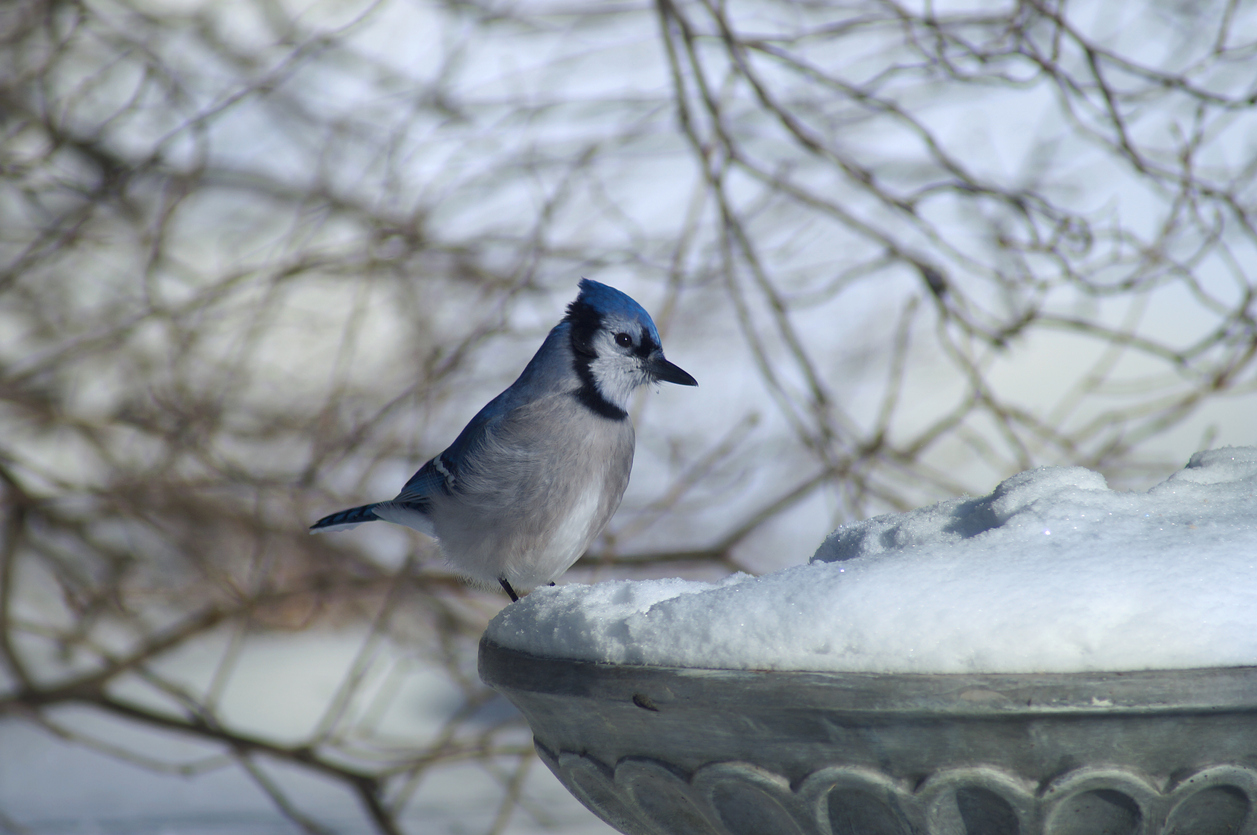
Birds need to drink year round, but finding sources of water in the coldest months can be difficult. A birdbath lets even small birds perch for a drink, but if you live in an area where temperatures routinely dip below freezing, a heated birdbath, such as the GESAIL Heated Bird Bath, will prevent the water from turning to ice. You may even spot birds who mostly dine on insects, not seed from a feeder, stopping by for a drink and a quick bath.
RELATED: The Best Bird Baths, Tested and Reviewed
8. Set out a ground feeder.
Many species of birds, including native sparrows, juncos, and towhees, find food by foraging on the ground. Snow makes it difficult for them to find the seeds and grains they need to survive, so help them out with a ground feeder. The Gray Bunny Bird Feeder Tray, for example, holds up well to winter weather. Position the feeder close to protective cover, such as shrubs or trees, but be sure passing birds can spot it from overhead. Brush away snow or ice each day, and fill the ground feeder with a birdseed blend containing a variety of seeds and nuts.
“Suet is a great food to offer many of the birds that will visit backyards in the winter. Suet is a high-energy, pure fat substance which is invaluable in winter when insects are harder to find and birds need many more calories to keep their bodies warm.”
—Dr. Roger Lederer, Ornithologist and emeritus Professor of Biological Sciences at California State University, Chico
9. Hang a suet feeder.
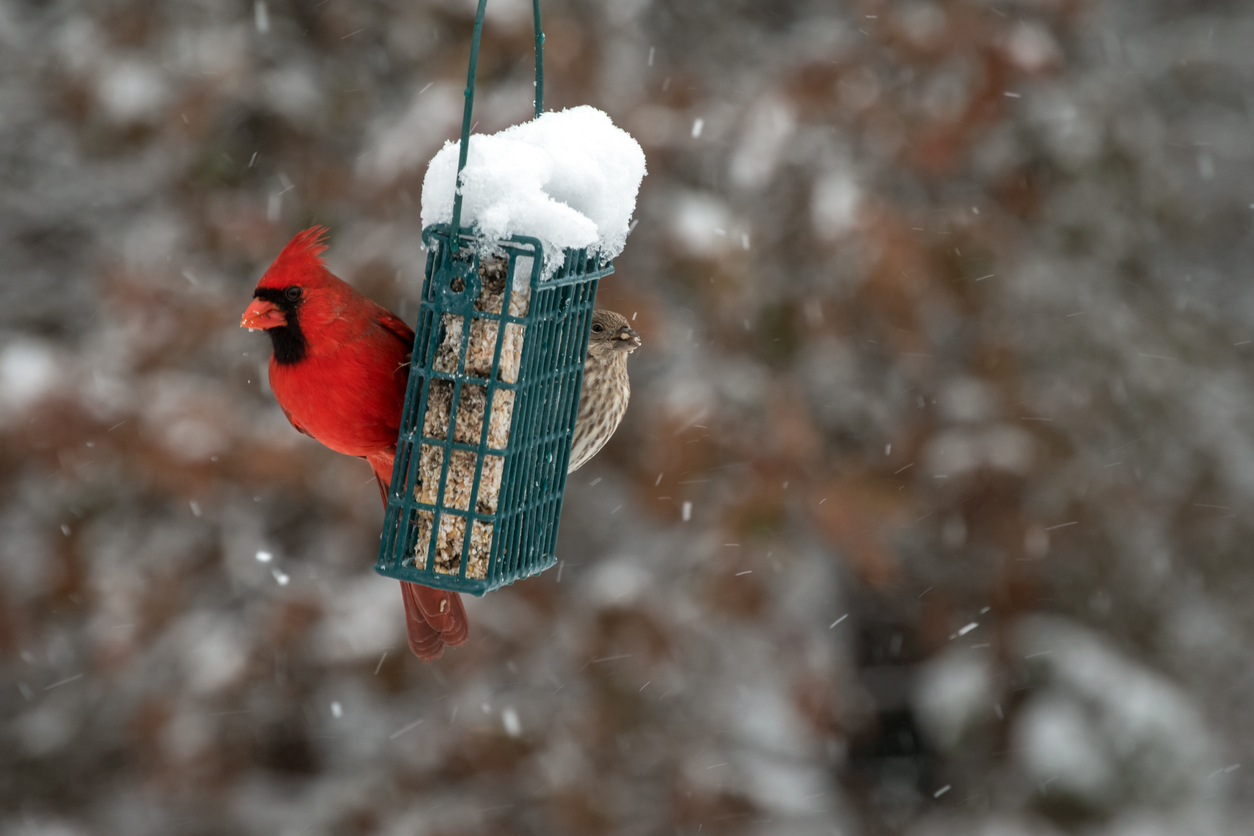
Cold weather increases the demands on a bird’s energy, so protein-rich foods, which help maintain a bird’s high metabolism, are very important during the winter. Along with your usual bird seed offerings, hang a suet feeder; suet is compressed raw fat often studded with seeds, peanut butter, or berries. The More Birds Suet Feeder holds two cakes of suet for double the feedings. Don’t be surprised to spot birds that you don’t often see at feeders otherwise—including jays, woodpeckers, chickadees, nuthatches, and orioles—devouring the suet.
